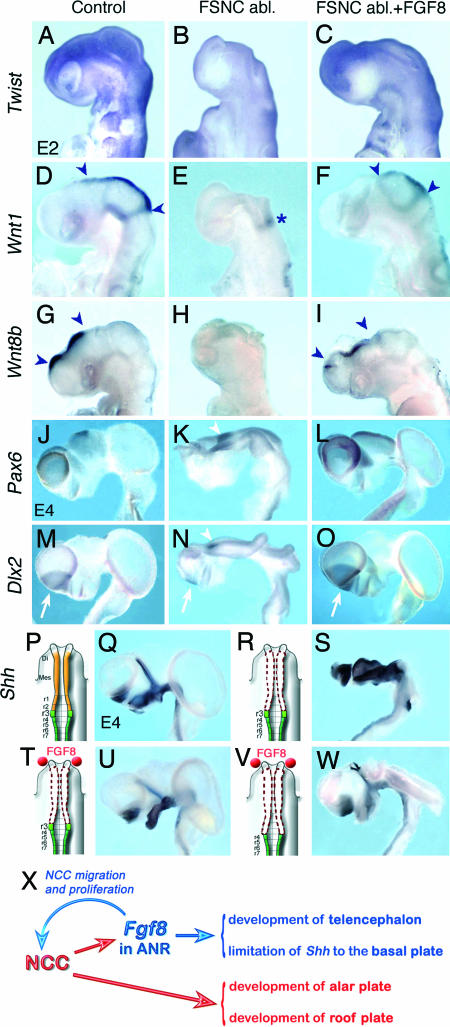Fig. 2.
NCC progression in the forehead territory restores brain patterning. Gene expression in NCC and cephalic neuroepithelium in control (A, D, G, J, M, and Q); FSNC-ablated (B, E, H, K, N, and U); and FGF8-treated, FSNC-ablated (C, F, I, L, O, and S) embryos. (A) At 24ss, Twist is activated in NC that populate BA and nasofrontal primordium along with the presumptive calvarial domain. In addition, a fringe of Twist-labeled cells likely devoted to the development of the calvarium was present on the dorsolateral aspects of the cephalic vesicles. (B) In stage-matched FSNC-ablated embryos, no Twist transcript is evidenced in the developing head. (C) When supplemented with exogenous FGF8, embryos exhibit Twist expression in the nasofrontal region and an expanded expression domain laterodorsally to the telencephalic and diencephalic vesicles. (D–F) At 24ss, Wnt1 expression in the dorsal mesencephalon and thalamus (D, arrowheads) is lost in the absence of FSNC except at the level of the isthmus (E, asterisk) but is restored when NCC progression is stimulated by FGF8 in ANR (F). (G–I) Expression of Wnt8b in dorsal diencephalon and telencephalon (G, arrowheads) is abolished in the absence of FSNC (H) but partly restored if embryos are treated with FGF8 (I). (J–L) At E4.5, Pax6 expression in pallium and dorsal diencephalon (J) is reduced in telencephalon but up-regulated in P3 (K, arrowhead) in the absence of FSNC, whereas treating with FGF8 rescues normal pattern of expression in dorsal prosencephalic vesicles (L). (M and N) At this stage, Dlx2 expression in ganglionic eminence (M, arrow) is severely perturbed in FSNC-deprived embryos (N). (N) Dlx2 remains as a small focus in telencephalon (N, arrow) and is overexpressed in P3 (N, arrowhead). (O) Exogenous FGF8 restores Dlx2 in telencephalon (arrow). (P and Q) In normal development, Shh is expressed in the prosencephalic basal plate. (R and S) In FSNC-deprived embryos (R), Shh transcript accumulation is expanded at the expense of the alar plate (S). (T) With FGF8 supply, Shh expression tends to normalize. (V and W) Suppressing r3 together with FSNC (V) in FGF8-treated embryos does not severely perturb the pattern of Shh expression while brain is exencephalic (W). (X) Schematic representation of the role of NCC in brain development.

